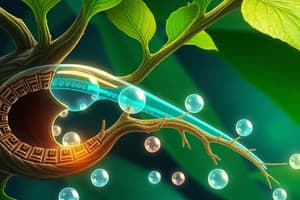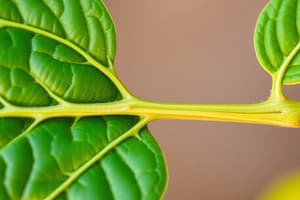Podcast
Questions and Answers
What is the primary direction of water transport in the xylem?
What is the primary direction of water transport in the xylem?
- Horizontally across the plant
- In multiple directions simultaneously
- Downwards towards the roots
- Upwards towards the leaves (correct)
Which process helps create a concentration gradient for sugar transport in plants?
Which process helps create a concentration gradient for sugar transport in plants?
- Active transport of minerals
- Passive diffusion of gases
- Osmosis of water into sieve tubes (correct)
- Evaporation of water
What is the role of lignin in xylem cells?
What is the role of lignin in xylem cells?
- Retains moisture in the cells
- Provides structural support (correct)
- Helps in sugar transport
- Facilitates passive transport
What type of transport requires energy in the form of ATP?
What type of transport requires energy in the form of ATP?
How do companion cells assist in sugar transport within phloem?
How do companion cells assist in sugar transport within phloem?
What is a disadvantage of asexual reproduction in plants?
What is a disadvantage of asexual reproduction in plants?
Which part of the flower is responsible for attracting pollinators?
Which part of the flower is responsible for attracting pollinators?
In which type of reproduction do plants typically require meiosis?
In which type of reproduction do plants typically require meiosis?
What is the function of guard cells in plant leaves?
What is the function of guard cells in plant leaves?
What characteristic of the stomata facilitates gas exchange in plants?
What characteristic of the stomata facilitates gas exchange in plants?
Which of the following best describes a hypertonic solution?
Which of the following best describes a hypertonic solution?
What is the role of xylem tissue in a plant?
What is the role of xylem tissue in a plant?
What type of seed dispersal involves the movement of seeds by animals?
What type of seed dispersal involves the movement of seeds by animals?
Which plant structure protects the flower bud before it opens?
Which plant structure protects the flower bud before it opens?
What is a primary advantage of sexual reproduction for plants?
What is a primary advantage of sexual reproduction for plants?
Flashcards
Water Transport in Plants
Water Transport in Plants
The upward movement of water and minerals through xylem vessels in plants. This process relies on transpiration, the evaporation of water from leaves, creating a negative pressure that pulls water up like a straw.
Transpiration
Transpiration
The evaporation of water from the leaves of plants, which creates a negative pressure that draws water up from the roots. This process is essential for water transport.
Translocation
Translocation
The process of transporting sugars produced during photosynthesis from source (where they are made) to sink (where they are needed). This occurs in the phloem.
Cohesion
Cohesion
Signup and view all the flashcards
Adhesion
Adhesion
Signup and view all the flashcards
Asexual reproduction
Asexual reproduction
Signup and view all the flashcards
Mitosis
Mitosis
Signup and view all the flashcards
Lack of genetic diversity
Lack of genetic diversity
Signup and view all the flashcards
Self-pollination
Self-pollination
Signup and view all the flashcards
Cross-pollination
Cross-pollination
Signup and view all the flashcards
Seed dispersal
Seed dispersal
Signup and view all the flashcards
Upper epidermis
Upper epidermis
Signup and view all the flashcards
Chloroplast
Chloroplast
Signup and view all the flashcards
Osmosis
Osmosis
Signup and view all the flashcards
Hypertonic
Hypertonic
Signup and view all the flashcards
Study Notes
Plant Transport
- Water is transported upwards in the xylem, a unidirectional process.
- Water movement is driven by transpiration, the evaporation of water from leaves, creating a pulling force.
- Minerals are transported with water. This process is called translocation.
- Xylem cells are dead at maturity, enabling efficient water movement.
- Xylem cells have thick, lignin-rich walls for structural support.
Water Adhesion and Cohesion in Xylem
- Cohesion: Water molecules stick together due to their polarity, forming a continuous chain.
- Adhesion: Water molecules stick to the xylem walls, resisting downward pull of gravity.
Transport Mechanisms
- Passive Transport: Movement of molecules along a concentration gradient (no energy needed).
- Active Transport: Movement of molecules against a concentration gradient (requires energy).
Translocation (Phloem Transport)
- Phloem transports sugars from sources (production sites, like leaves) to sinks (areas needing resources, like roots or developing fruits).
- This is an active process.
- Companion cells use active transport to load sugars into sieve tube elements, creating a pressure difference driving transport.
Asexual Reproduction (Mitosis)
- Asexual reproduction produces clones (genetically identical offspring).
- Advantages include adaptation to specific environments and fewer energy requirements.
- Disadvantages include limited adaptability to changing conditions due to lack of genetic diversity.
- Examples include runners in strawberries, root fragments in dandelions and modified stems in potatoes.
Sexual Reproduction (Meiosis)
- Sexual reproduction involves meiosis.
- Flowers are the reproductive organs.
- Advantages include adaptability to new environments and enhanced resilience during stress.
- Disadvantages include the high energy expenditure for meiosis and pollination.
- Example: Pollination in flowering plants.
Flower Anatomy
- Sepals: Protect the flower bud.
- Petals: Attract pollinators.
- Stamen (male): Anther (pollen producer) and filament.
- Carpel/Pistil (female): Stigma, style, and ovary.
Pollination
- Self-Pollination: Pollen transfer within the same flower or plant.
- Cross-Pollination: Pollen transfer between different flowers or plants (usually by wind or animals).
Seed Dispersal
- Seeds disperse to prevent competition and expand the plant's range.
- Methods include:
- Fruit (transport by animals)
- Lightweight seeds (wind dispersal)
- Sticky seeds (animal dispersal)
Leaf Structure
- Upper epidermis/cuticle: Protect against water loss and pathogens.
- Chloroplasts: Carry out photosynthesis.
- Palisade mesophyll: Maximize light absorption.
- Veins: Contain xylem and phloem for transport.
- Spongy mesophyll/air spaces: Facilitate gas exchange.
- Guard cells: Regulate stomata opening/closing.
- Stomata: Allow gas exchange (CO2 in, O2 out) and transpiration (water out).
Osmosis
- Osmosis is the movement of water across a selectively permeable membrane from a high water concentration to a low water concentration.
- Key terms include:
- Solute: Dissolved substance
- Hypertonic: Higher solute concentration
- Isotonic: Equal solute concentration
- Hypotonic: Lower solute concentration
Studying That Suits You
Use AI to generate personalized quizzes and flashcards to suit your learning preferences.





